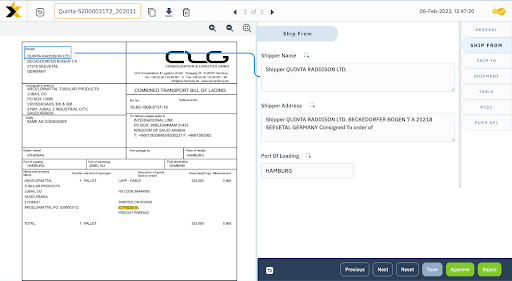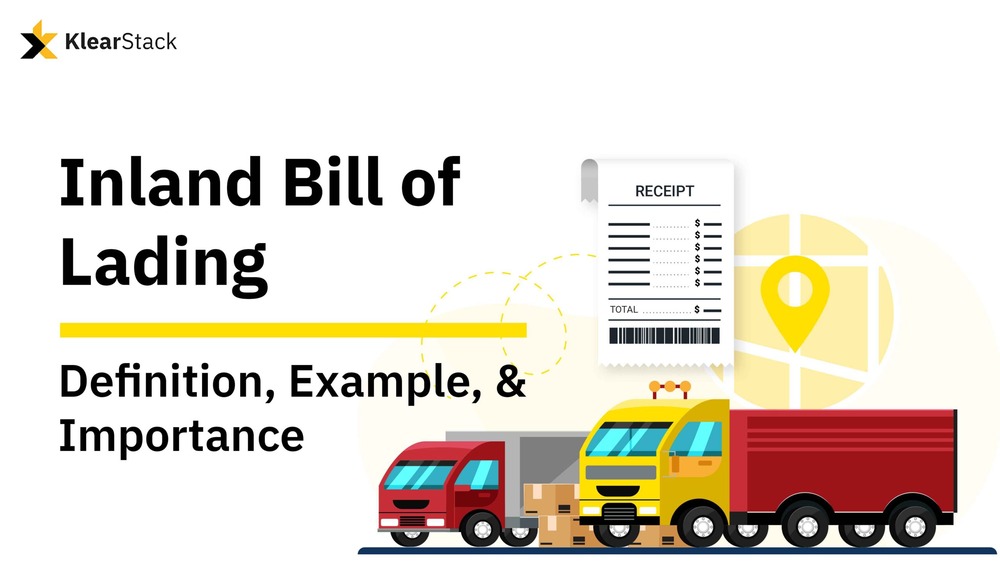What is an Inland Bill of Lading?
An Inland Bill of Lading is a document signed between the carrier (a transportation company) and the shipper. The contract is signed when goods need to be transported within the borders of a single country.
It serves as a receipt, outlining the agreement between the shipper and the carrier for the inland journey, detailing shipment specifics, and acknowledging receipt of the goods.
The Inland bill of lading outlines key details such as:
- Details of the shipper, consignee, and carrier for clear identification.
- Specifics on the type, quantity, and condition of the goods.
- Information about the land-based mode of transport and the route.
- Locations of goods pickup and final delivery within the same country.
- Record of the date when the carrier received the goods.
- Agreed-upon terms governing the transportation contract.
- Clear breakdown of associated costs and freight charges.
While similar in purpose to an Ocean Bill of Lading used in international shipping, the Inland Bill of Lading is tailored for domestic transport, providing a comprehensive record of the agreement between the shipper and the carrier.
Example of Inland Bill of Lading
Consider a scenario where the U.S.-based electronics manufacturer is shipping products to a retailer within the country:
|
[Carrier Logo] [Carrier Name, Inc.] [Carrier Street Address, City] [Carrier Phone, Email, etc.] |
||
|
Shipper: |
ABC Electronics, Inc. 123 Tech Lane Cityville, USA Phone: [Shipper Phone], Email: [Shipper Email] |
|
|
Consignee: |
Retail Gadgets, LLC 456 Retail Street Shopville, USA Phone: [Consignee Phone], Email: [Consignee Email] |
|
|
Description of Goods: |
Product 1: | Smartphones, 100 units |
| Product 2: |
Laptops, 50 units |
|
|
Transportation Details: |
Mode: | Truck |
|
Route: |
Cityville to Shopville |
|
| Trans-shipment Points: |
None |
|
|
Origin & Destination: |
Pickup Location: | ABC Electronics Warehouse, Cityville |
| Final Destinantion: |
Retail Gadgets Store, Shopville |
|
|
Date of Shipment: |
[Current Date] |
|
|
Terms & Conditions: |
|
|
|
Charges and Fees: |
Freight: |
$500 |
|
Handling Fee: |
$50 |
|
|
Notable or Special Instructions: |
|
|
|
Signature and Seal: |
[Signature of Shipper Representative] | |
|
[Signature of Carrier Representative] |
||
|
[Carrier Seal] |
||
What is the Purpose of the Inland Bill of Lading?
An Inland Bill of Lading and a bill of lading share the fundamental purpose of serving as crucial documents in the transportation of goods. However, they differ in their scope and usage.
For instance, the inland bill of lading addresses domestic logistics and trade. But the bill of lading navigates global trade and international standards.
By understanding this—stakeholders can choose appropriate documents based on the—nature, destination, and mode of transportation for their specific shipment.
They can consider the following questions—to determine if an inland bill of lading is what they require:
- Is the shipment intended for domestic transport within the borders of a single country?
- Is the shipment intended for domestic transport within the borders of a single country?
- Are all parties involved in the shipment, including the shipper, carrier, and consignee, based within the country’s borders?
- Are there legal or contractual requirements specific to domestic shipments that need to be adhered to?
Parties Involved in an Inland Bill of Lading
It is noteworthy that the buyer himself is not directly involved in the issuance of the inland bill of lading, unless he’s the consignee.
Following are the parties involved in an inland bill of lading:
- Shipper (Consignor): The entity or individual sending the goods. They initiate the shipment and engage with the carrier to transport the goods domestically.
- Carrier (Transport Company): Responsible for physically transporting the goods. The carrier issues the Inland Bill of Lading to the shipper upon receiving the goods, confirming the agreement.
- Consignee (Receiver): The party or entity to whom the goods are being shipped. The consignee is typically listed on the Inland Bill of Lading and is entitled to claim the goods upon arrival.
- Notary or Witness (Optional): Some transactions may involve a notary or a witness to authenticate the document, depending on legal or contractual requirements.
When to Consider Other Bills of Lading?
Since there are a variety of bills of lading to choose from—it’s a good idea to consider which one is best for your trade needs.
You might want to consider other bills of lading if your shipment involves global trade and requires documentation for sea transport. Or, if you require flexibility in transferring ownership during the shipment. In that case, a Negotiable Bill of Lading may be suitable.
If your Goods have specific conditions or issues, then consider a Claused Bill of Lading. If you prefer a standardized document format, make the Uniform Bill of Lading a suitable choice.
Automate Your Bill of Lading Processing with KlearStack.
KlearStack is an AI-driven intelligent document processing solution to help you automate your inland bill of lading needs.
The automated tool lets you set up predefined rules & formats to check whether details like names, addresses, and product descriptions are accurate.

With the help of KlearStack, you can–
✓Cut costs upto 70%.
✓Achieve 99% Accuracy.
✓Reduce manual effort upto 90%.
FAQs on Inland Bill of Lading
What is an example of an inland bill?
An example is a truck transporting goods within a country, where the Inland Bill of Lading serves as a receipt and contract for the domestic transport, detailing shipment specifics and the agreement between the shipper and the carrier.
What is the difference between inland bill of lading and ocean bill of lading?
The key difference lies in scope. An Inland Bill of Lading covers domestic land transport, while an Ocean Bill of Lading is used for international sea shipments, encompassing the entire journey from port to port.
What is inland shipment?
Inland shipment refers to the transportation of goods within the boundaries of a single country. It involves land-based modes like trucks or trains, and an Inland Bill of Lading is used to document and facilitate domestic transport.
What are the two types of bills of lading?
The two main types are “Negotiable” (transferable ownership) and “Nonnegotiable” (specific to a consignee). Each serves distinct purposes in facilitating the receipt, transportation, and delivery of goods in domestic and international trade.







